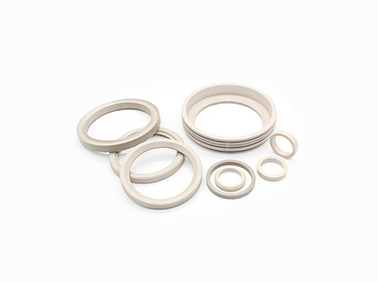In nuclear power plants, radiation medicine, space exploration, and nuclear waste treatment, radiation-resistant sealing materials serve as the final lifeline for ensuring system safety and preventing radioactive leaks. Under continuous bombardment by high-energy particles and rays, these materials must maintain structural integrity and performance stability. Their technological breakthroughs directly impact environmental safety and human health.
I. Extreme Challenges of Radiation Environments: Beyond Conventional Destruction
- High-Energy Particle Impact: Gamma rays, neutron flux, and α/β particles directly break polymer chains (chain scission), causing cross-linking or degradation that destroys material foundations.
- Synergistic Oxidative Corrosion: Radiation fields often coexist with strong oxidation (e.g., high-temperature pressurized water, strong acids, reactive oxygen), accelerating material aging and embrittlement (radiation-oxidation synergy).
- Extreme Pressure-Temperature & Chemical Corrosion: High-temperature/pressure water in reactors and corrosive nuclear waste media (e.g., nitric/hydrofluoric acid) create compounded stresses (thermal creep, pressure penetration, chemical attack).
- Zero-Leakage Mandate: Permissible radioactive leakage rates in nuclear facilities are near-zero, where conventional seals fail catastrophically.
II. Core Technical Strategies: Breakthroughs in Material Design
- High-Performance Organic Polymers: Precision-Engineered Radiation Warriors
- Aromatic Polymers:
- Polyimide (PI): Rigid heterocyclic structures (e.g., PMDA-ODA) resist chain scission. Backbone fluorination enhances heat resistance (>350°C) and anti-swelling.
- Polyetheretherketone (PEEK): Semi-crystalline nature withstands gamma doses >10⁹ Gy. Glass/carbon fiber reinforcement (>40%) overcomes cold flow.
- Polyphenylene Sulfide (PPS): High crosslink density maintains dimensional stability under radiation. Ceramic-filled grades excel in steam resistance.
- Specialty Elastomers:
- Fluororubber (FKM): Perfluoroelastomers (FFKM) exceed 300°C. Nano-silica (e.g., Aerosil R974) preserves post-radiation sealing force.
- Hydrogenated Nitrile Rubber (HNBR): High saturation (>98% hydrogenation) reduces oxidation sites. Peroxide curing enhances crosslink stability.
- EPDM Rubber: Non-polar backbone lowers radiation sensitivity. Nuclear-grade formulations (e.g., radical scavengers) achieve low leakage at 10⁸ Gy.
- Aromatic Polymers:
- Inorganic Non-Metallic Systems: Intrinsic Radiation Immunity
- Ceramic Matrix Composites:
- Alumina/Silicon Nitride Seal Rings: High melting point (>2000°C) and intrinsic chemical inertness resist radiation. Precision sintering (>99.5% density) enables zero-leakage nuclear pump seals.
- Flexible Graphite Packing: High-purity expanded graphite (>99.9% carbon) forms radiation-tolerant microcrystalline structures. Nuclear grades require AMS 3892 radiological decontamination certification.
- Metal-Ceramic Functionally Graded Materials (FGM): Plasma-sprayed zirconia/Hastelloy layers (10-100μm transition zones) prevent thermal shock cracking.
- Ceramic Matrix Composites:
- Metal Matrix Systems: Engineered Resilience
- High-Nickel Alloy Bellows: Laser-welded Inconel 625/718 bellows (0.1-0.3mm wall) withstand >10⁹ fatigue cycles in reactor coolant pumps.
- Silver-Clad Metal Gaskets: Nuclear valve gaskets with 0.1mm Ag layer on low-carbon steel (08F) achieve sealing pressures >300 MPa.
III. Peak Performance Matrix: Data-Driven Reliability Assurance
| Property | Nuclear-Grade Polymers | Ceramic Seals | Metal Systems |
|---|---|---|---|
| Gamma Resistance | >10⁹ Gy (PEEK) | >10¹⁰ Gy | >10⁹ Gy |
| Neutron Fluence Limit | 10¹⁷ n/cm² | >10²¹ n/cm² | >10¹⁹ n/cm² |
| Temp. Range | -50~+350°C (FFKM) | >1200°C (SiC) | -200~+800°C |
| Sealing Pressure | 45 MPa (PEEK valve seat) | 100 MPa (SiC face seal) | 250 MPa (high-P valve) |
| Helium Leak Rate | <10⁻⁹ mbar·L/s | <10⁻¹² mbar·L/s | <10⁻¹¹ mbar·L/s |
IV. Critical Applications: Guardians of Nuclear Safety
- Nuclear Power Plant Core:
- Reactor Vessel Metal O-Rings (Inconel 718 + Ag coating)
- Coolant Pump Tandem Seals (SiC/SiC pairs)
- Control Rod Drive Spring-Energized Seals (nuclear PEEK)
- Nuclear Waste Processing:
- High-Level Waste Tank Silver Gasket Systems
- Vitrification Furnace Valve Seals (ceramic composite)
- Radiation Medicine:
- Proton Therapy Gantry Dynamic Seals (radiation-modified PTFE)
- Gamma Knife Source Capsule Dual Metal Seals
- Deep Space Nuclear Power:
- Radioisotope Thermoelectric Generator (RTG) Multilayer Insulation Seals
- Nuclear Thermal Propulsion Hydrogen Environment Seals
V. Cutting-Edge Advancements: Material Science Frontiers
- Self-Healing Seals: Microencapsulated agents (e.g., DCPD + Grubbs catalyst) enable in situ radiation damage repair.
- Nano-Composite Breakthroughs: Boron Nitride Nanosheet (BNNS)-reinforced PI films maintain >90% post-radiation strength.
- 4D-Printed FGMs: Spatially graded stiffness adapts to localized radiation exposure.
- HPC Material Design: Molecular dynamics simulations predict million-year radiation aging.
Conclusion: Foundation of Extreme Environment Safety
From reactor cores to deep space, radiation-resistant sealing materials are foundational to safety through revolutionary innovation. As Gen-IV reactors, fusion devices, and interstellar missions advance, demands for higher temperature resistance, radiation tolerance, and longevity escalate. Only through relentless material science innovation can we forge an impenetrable shield for humanity’s peaceful use of nuclear technology.
Post time: Jul-12-2025

